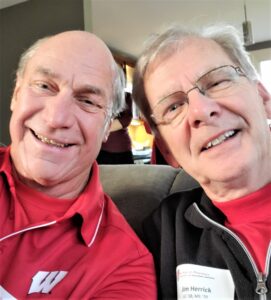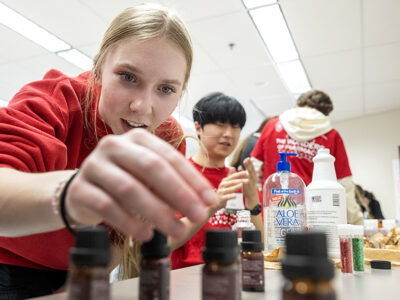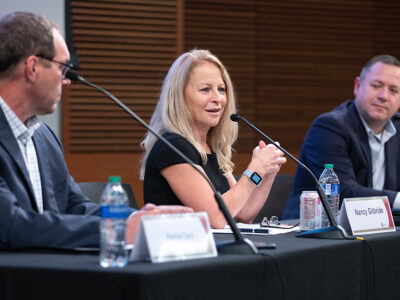
9
December

Alum Rod Ammerman has forged an innovative career at the intersection of pharmacy and information technology
By Katie Ginder-Vogel
As a pharmacy student at the University of Wisconsin–Madison School of Pharmacy, Rod Ammerman (BS ‘78) had the opportunity to be a pharmacy technician at UW Hospital. He was exposed to bulk compounding for the first time and passed oral and injectable medications to patients — all critical elements of a pharmacist’s repertoire.
But he also took on one more responsibility as a pharmacy technician that wound up taking him off the beaten path: On nights and weekends, he was the operator of the pharmacy computer system.
“By working as a pharmacy technician in so many different roles, I was able to observe how a pharmacy computer system supported the entire pharmacy operation,” says Ammerman. “I discovered that my aptitude for using computer systems to support pharmacy operations was quite good.”
That early experience gave him his footing in information technology and led him to found ComSult Enterprises, LLC, to provide and manage clients’ home infusion information systems. The business has been going strong for more than 25 years, serving hospitals and commercial clients around the country.
Foundation in hospital pharmacy
After pharmacy school, Ammerman initially continued on the practice route and took a position at the William S. Middleton Veterans Memorial Hospital. He enjoyed the hospital environment and was interested in doing similar work to what he’d done at UW Hospital.
“What I enjoyed about the hospital environment was the ability of the pharmacy to be creative and implement care models that intertwined the clinical training of the pharmacist,” he says.
But he quickly realized he wasn’t in his element — at the time, the VA had no computer system. Ammerman, with a growing interest in the information technology side of health care, decided to instead pursue a residency.

“I was matched with Jim Herrick (BS ‘68, MS ‘70) at United Hospitals in St. Paul, also a UW and pharmacy residency grad,” says Ammerman. “At the time, they had one of the more innovative hospital pharmacy systems and practice affiliations in the country.”
They also had a dial-up teletype machine that connected them to the University of Minnesota to support their pharmacokinetic dosing program. Ammerman leveraged his experience at UW Hospital and got involved in United Hospitals’ computerization process. He wrote a justification for his department to be the first to purchase an Apple computer with a floppy disk drive. After enlisting a small team of pharmacists to learn how to program the new Apple, pharmacokinetic dosing was transferred from the mainframe to the Apple. A new era was born.
Soon after, the same team developed TPN (total parenteral nutrition) programs for their adult, pediatric, and neonatal patients who were unable to eat and were receiving infusion therapies. The software would calculate the proper composition of proteins, carbohydrates, electrolytes, and other essentials each patient needed.
“Before the TPN software, TPN formulations were calculated and balanced manually. The work was time consuming, complex and prone to errors,” says Ammerman. “The addition of the TPN software saved countless pharmacist hours and greatly improved the accuracy of complicated TPN formulations.”
Pivot from patient care
United Hospitals’ residency program incorporated outreach to small hospitals in the Twin Cities area that lacked or had only rudimentary pharmacy services. During his residency and post-graduation, he was responsible for developing and managing pharmacy services in several rural hospitals. The first contracted hospital to implement modern hospital services was Amery Regional Medical Center.
“They had a drug room downstairs, with narcotics in an old safe. There were no controls. In the first six months, we implemented a Medication Administration Record (MAR), which also supported a unit dose and patient billing,” says Ammerman. “I hired Mark Tryggestad (BS ‘78), my best friend in pharmacy school, and he will retire from there. They went from a one-room pharmacy to having pharmacy services as good as any large institution.”
Ammerman moved on to become the assistant director at United for eight years, until hospital systems started to merge and form big conglomerates.

“Suddenly, department innovation moved up to corporate headquarters, and we no longer had freedom to innovate,” he says. He remembered what he enjoyed about his early work with infusion therapies and decided it was time for a change.
“Home infusion was a new frontier and innovation was mandatory,” he says. “I knew folks in Texas who worked for HMSS, a home infusion therapy company, so I went down there and was manager of operations development for 20 branches across the country.”
At HMSS in 1988, Ammerman found himself without any automated pharmacy system. Each branch facility had an IBM computer that served as a typewriter to print labels.
“We tracked deliveries and billing on Lotus and sent Lotus sheets to the corporate office, and they would do all kinds of shenanigans to merge them and bill insurers,” he says. “There were no systems to run home infusion.”
Three years later, Ammerman moved to Indiana to handle sales and operations for a smaller home infusion business, then consulted for hospitals.
An entrepreneurial leap
He launched his own business in 1991, ComSult Enterprises, LLC, to provide and manage clients’ home infusion information systems. ComSult provides revenue cycle management and systems support to hospital-based home infusion providers.
He purchased one of the first information technology systems for home infusion and began using it for billing.
“It was before cloud computing and just after the age of hard drives, so we kept a mirror image of the client system at the site where my staff worked, and we’d have to dial in with modems to move data back and forth and do the billing,” says Ammerman. “I hired people I’d worked with in Indiana, and they still work for me today.”

In 1994, Ammerman’s former mentor Jim Herrick called. He was a vice president at Advanced PCS, a pharmacy benefit management company, and he needed help building an automated system for manufacturer rebate contracts.
“I moved back to Minneapolis and joined the PBM world,” says Ammerman. “I did rebates for about three years, then worked on backend medication systems that analyzed patients’ medication adherence and developed education programs.”
All the while, ComSult Enterprises continued operations, and when Ammerman left PCS in 2002, he decided to dedicate himself to his own business full-time. By this time, businesses could use a co-located server, so Ammerman bought a server, and his clients could dial up and use the same system ComSult was using.
“We didn’t have to move data back and forth anymore,” says Ammerman. “We were doing cloud stuff before there was a cloud.”
As technology progressed, Ammerman moved his team to a web-based service at the first opportunity. Now, of course, ComSult uses cloud servers for its clients.
Ammerman is happy with the size of his company and encourages others to consider the path of entrepreneurship.
“I’ve had a pretty good life,” he says. “I have a philosophy that I will never wish I spent more time in the office. I made a commitment to myself that at minimum, my teeter-totter would be balanced between work and life. I probably had a lot more fun than I should have.”
Flexible profession
Ammerman says many of his friends and pharmacy alumni colleagues have also followed nontraditional pharmacy careers, often leading to new businesses. For example, his friends Jeff (BS ’76) and Patti (BS ’78) Langer founded Pet Apothecary in Milwaukee.
“Jeff loved to compound and likes doing it for animals, and he has been unbelievably successful in that,” says Ammerman. “Pet Apothecary provided a great service and has expanded the capabilities of what veterinarians have available to them.”
“Pharmacists have a huge amount of knowledge and expertise to fall back on. But you have to be willing to take chances; there are no givens.”
—Rod Ammerman
Ammerman notes that a pharmacy degree provides job security that makes it possible to take career risks.
“Pharmacists have a huge amount of knowledge and expertise to fall back on,” he says. “But you have to be willing to take chances; there are no givens.”







